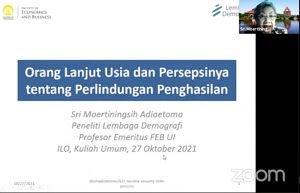Sri Moertiningsih in the Social Protection Public Lecture Series #5, ILO: Socio-Economic Conditions of the Elderly in Indonesia and Perceptions of Old Age Income Security
Nino Eka Putra ~ PR FEB UI
DEPOK – (27/10/2021) Researcher of the Demographic Institute and Professor Emeritus of the Faculty of Economics and Business, Universitas Indonesia (FEB UI), Prof. Sri Moertiningsih Setyo Adioetomo, Ph.D., was a resource person in the Public Lecture Series on Social Protection #5, entitled “Socio-Economic Conditions of the Elderly in Indonesia and Their Perceptions of Old Age Income Security” organized by the International Labor Organization (ILO) on Wednesday (27/10/2021).
In her presentation, Professor Sri Moertiningsih Setyo Adioetomo familiarly called Tuning explained that referring to the Bappenas and Golden Indonesia scenario (Advanced, Independent, Fair and Prosperous) in 2045, the number of elderly will amount to 63 million people. Currently, the number of elderly people is 28.7 million and every year it is increasing. The distribution of the elderly in Indonesia is mainly in Java and North Sulawesi.

In general, the older the elderly will naturally experience a decrease in physical capacity, cognitive (forgetfulness or senile), and changes in emotional stability. The biggest part of the elderly’s problems is income and health insurance. Most of the elderly have low education, and have no income security. In terms of education, the average elderly graduated from the SD Inpres in 1973, which was built by President Soeharto. Thus indicating that all villages in Indonesia at that time had to have one elementary school.
Meanwhile, in terms of health, more than half of the elderly suffer from more than 1 disease or comorbidity. During the Covid-19 pandemic, the highest mortality rate was found in the elderly, with 16.5% aged 65 years and over dying when infected with the Covid-19 virus; compared to 9.4% aged 55-64 years, and 4.7% aged 44-54.
Meanwhile, elderly men tend to remarry when their partner dies, while elderly women choose to be widowed. Elderly living arrangements show that 14.1% of elderly women live alone; 43% of elderly men and women live with their children and grandchildren; 25.5% male elderly live with a partner; and 32.9% male elderly live with their families.
“The feminization of aging includes more elderly women than elderly men, women live longer but their health-adjusted life expectancy is shorter than men, elderly women tend to live alone, are poorer and have more disabilities than elderly men” Prof. Tuning explained.
Evidence from the 2015 BPS Inter-Census Survey (SUPAS) show that almost half of the elderly respondents (49.8%) obtained resources and transfers from formal transfers 4% (retirees), 71.6% informal transfers (from children, grandchildren, son-in-law or other families), and 23.6% from formal and informal transfers. Meanwhile, around 10.7% of the elderly have income from work (92.5% work income, 0.9% non-work income, and both 6.6%). Finally, most of the elderly 16-27% need other sources of income to meet their basic needs.
“This indicates that a large number of the elderly depend on informal transfers to cover their expenses and there is a need to expand the coverage of social protection for the elderly so that they can enjoy a quality life,” Prof. Tuning stated as she concluded the session. (ts)
(am)

